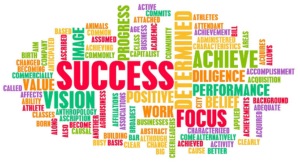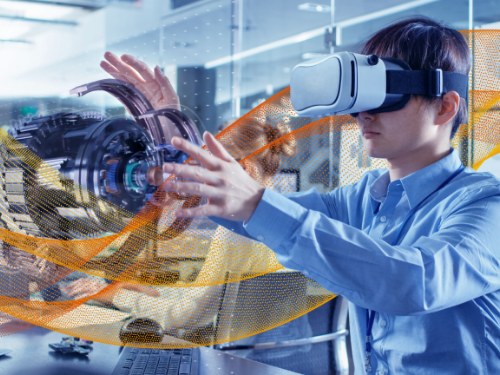Ever wish you had a magic tool to help communicate trends, patterns, and insights based on complex data sets? Luckily, that tool exists, and it’s something you’ve already seen and used in its most simplistic form – data visualization. It’s believed that around 65% of people are visual learners, so it’s not surprising that data visualization tools are so effective and widely used in many industries.
Data visualization can be simple or complex, ranging from simple charts, graphics, and maps, to more complicated visual representations. These tools analyze complex data sets, identify patterns, extract valuable insights, and present it in a visual format that’s easy to digest and make informed decisions from. Take a look at this very simple example from Tableau using a word cloud chart to emphasize the frequency (and thus importance) of a set of words. The more important or frequently used a word is, the larger and brighter it appears.

This data visualization example is rudimentary but effective. Advanced data visualization is more than just converting data into charts and graphical formats. It’s part of a company’s BI (business intelligence) strategy that generates new insights and helps communicate them more effectively, making for easier understanding, collaboration, and decision-making. And with the overconsumption of content in today’s world, who doesn’t want help making well-informed, smart decisions?
The value of data visualization is clear, but how do you know which type of data visualization is right for your need? Especially with AI entering the chat, there are several types of data visualizations to consider. Here are 5 data visualization types that you should know about.
1. Interactive Visualizations
People have been using static data visualizations like charts and maps for centuries, but what makes data visualization more useful is the ability to manipulate it. Interactive data visualization allows users to interact with the data directly within the visualization itself to explore and better understand it. The ability to interact with the data has a number of benefits compared to traditional static data visualizations. It provides a more immersive experience that lets users feel empowered to explore the data in more depth. It also helps uncover insights like patterns and trends that might not have been obvious in a static format. All of this leads to better data-driven decisions.
2. Collaborative Analytics & Visualizations
We can’t talk about collaborative data visualization, sometimes known as social business intelligence, without discussing analytics. Analytics plays a huge role in business operations, but understanding all the different data points can be a complicated and overwhelming venture. Using business intelligence (BI) software, organizations can collaborate on shared goals faster and be better aligned cross-functionally. The key to this is embedded analytics. Traditional BI systems rely on data stored on an internal database, but embedded analytics integrates BI tools and functionality into business applications which gives users access to data and insights directly within your applications (such as websites, apps, CRM, etc.). The convenience and accessibility of these insights allow for even more collaboration and faster decision-making between teams. Some of the most popular BI tools on the market today include Microsoft’s Power BI, Tableau, Qlikview, and Domo.
3. VR and AR Visualizations
You haven’t splurged $16k on family movie night using Apple’s Vision Pro VR/AR headset? Neither have we. But we have learned how AR and VR can create more immersive data visualization experiences by enabling users to engage with data in three-dimensional spaces. Users can see the various layers of datasets with additional context that spreadsheets or traditional visualizations can’t convey. A larger density of data can be shown at once, which allows for much faster cognitive processing compared to 2D visualizations. This new “immersive analytics” field will help data scientists tell better stories by breaking down the complexity of the data, offering more involvement and understanding in data analytics to everyone, not just data professionals.
4. Real-Time Data Visualizations
We’re constantly seeking the most up-to-date information and sources, so it makes sense that the most relevant data visualizations would be in real-time. Real-time data visualization allows you to monitor and analyze data as it’s generated, enabling users to make fast, informed, data-driven decisions. In addition to better, more confident decision-making, another huge benefit is improved accuracy and productivity. Real-time insights can help identify anomalies or errors as they occur, enhancing the reliability of the data. Typically, real-time data may involve working with sensitive or personal information, so it’s important to ensure that data security and privacy are accounted for. As more and more data continues to generate in real-time, the demand for real-time insights will grow.
5. AI-Powered Visualizations
At its core, artificial intelligence is the simulation of human intelligence processes though machines, and it has changed the way we problem solve. We could speak to the various definitions of AI, the different types, the implications, applications, and considerations, the ethical delimas, and more all day, (and probably lose some sleep over-thinking it). But right now we’re focused on AI’s impact on data visualization.
Traditional data visualization uses algorithms to create charts and graphs from data, whereas AI-driven visualization uses algorithms that can learn, understand, and respond to the data, potentially even better than a human can. AI-driven data visualization has several key benefits that the previous types of data visualizations don’t (at least not to the same extent). Automating repetitive tasks producing meaningful information is one of those. AI-powered data analytics can streamline your workflow and automatically generate personalized charts and graphs that easily communicate complicated information and insights. This saves time and resources, and combining the AI insights with human SMEs makes for better, well-informed decisions and smarter AI model builds that continue to improve as it learns more.
All of these data visualization types have the same common goal – to empower users to make faster and more confident data-based decisions. (See Bluetext’s blog on using data to create powerful PR narratives). With the rapid growth in AI, big data, data science, and machine learning, the importance of data and data visualizations for understanding and interpreting complex information will continue to surge.

